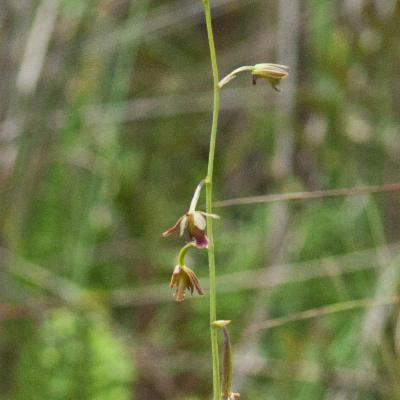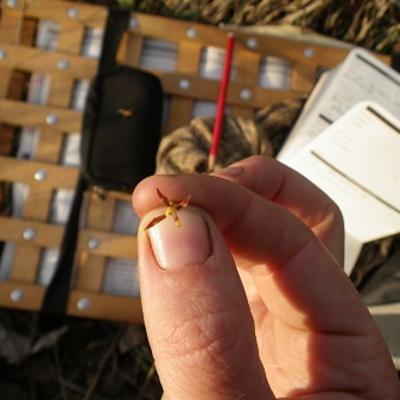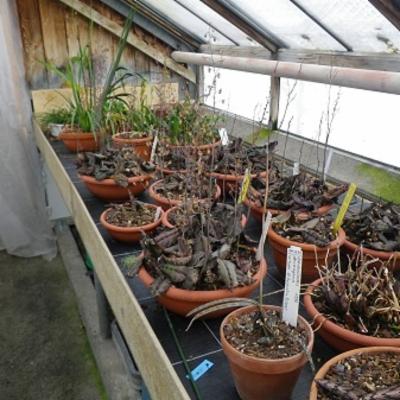Terrestrial herbs, rarely epiphytic.Pseudobulbs set close together, heteroblastic, ovoid to fusiform, 1–3-leaved at the apex.Leaves coriaceous, conduplicate, not plicate, often variegated, usually petiolate with the petiole articulate above the base.Inflorescences arising from base of the pseudobulb, simple or branched, several- to many-flowered.Flowers resupinate, relatively small, thin-textured.Sepals and petals free, variously spreading, subsimilar, the petals usually shorter and broader than the sepals.Lip spurred, 3-lobed, the mid-lobe usually 2-lobed or emarginate so that the lip appears 4-lobed; disk either with 2 quadrate or triangular calli at the mouth of the spur or with 3 variously thickened, parallel ridges which, together with the lateral veins, are sparsely but distinctly papillose or hirsute.Column erect, rather short, oblique at the base; anther cucullate or cristate; pollinia 2, ovoid or pyriform, on a short or rudimentary stipes; viscidium large; stigmata confluent; rostellum short.
Terrestrial or rarely lithophytic herbs. Roots basal. Perennating organ stem-like or pseudobulbous, cylindrical, fusiform, conical or ovoid, heteroblastic, often angular in cross-section. Leaves linear, lanceolate, ovate or elliptic, acute to acuminate, conduplicate and coriaceous or plicate, articulate at base, usually petiolate, green or mottled with light and dark green, rarely flushed with purple. Infl orescence lateral, usually exceeding leaves, simple or branching; bracts inconspicuous, persistent, rarely with an extrafl oral nectary. Flowers white, yellow, green or brown, sometimes purplestriped; labellum white or yellow with purple venation. Dorsal sepal free, erect to porrect, obovate to spatulate; lateral sepals oblique at base, otherwise similar to dorsal sepal. Petals free, similar or dissimilar to sepals, obovate to elliptic-oblong, often broader than sepals, often porrect. Labellum free to base, trilobed, spurred at the base, callose, lateral lobes free to base of column, midlobe fl at or convex; callus two- or three-ridged. Column with a distinct foot; pollinia two, ovoid or pyriform. Ovary cylindrical, grooved. (PC).
Terrestrial, rarely epiphytic herbs. Pseudobulbs close together, usually ovoid to fusiform, ± approximate, usually heteroblastic (with only one internode elongated, the remaining basal ones very short), apex 1–3-leaved, up to 15 cm. long and 3 cm. broad, but often narrower. Leaves usually with duplicate vernation, coriaceous, conduplicate, often variegated, usually petiolate, the petiole articulate some distance above the base and sometimes above the middle, the line of articulation consisting of a number of irregular blunt or acute teeth or occasionally ± regular. Inflorescences arising from the base of the pseudobulb, often exceeding the leaves, simply racemose or frequently paniculate; bracts inconspicuous, rarely with a basal extrafloral nectary. Flowers resupinate, rather small, thin in texture. Sepals and petals free, variously spreading, similar, the petals usually slightly shorter and broader. Lip decurved, spurred, 3- or apparently 4-lobed; side lobes erect; mid-lobe usually lobulate or emarginate; disc either with 2 approximate, quadrate or triangular calli at the spur entrance or with 3 variously thickened, parallel ridges which together with the lateral nerves are sparsely but distinctly papillose or hirsute. Column erect, short, oblique at the base or with a short foot; anther cucullate or cristate; pollinia 2, ovoid or pyriform, on a short or rudimentary stipe; viscidium large; stigmata confluent; rostellum short.











